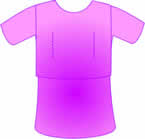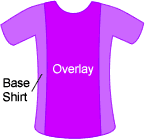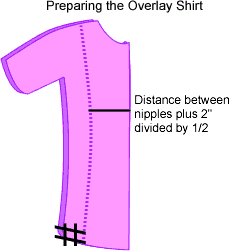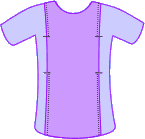Nursing shirts that don't break the budget!
 |
|
Nursing shirt with vertical overlay
|
 |
|
Nursing shirt with horizontal overlay
|
No doubt you've walked past the "Motherhood Maternity" stores and looked at their nursing clothes. I have, and realized early on that they didn't make anything in my size. Same deal with the majority of nursing clo thes makers whose catalogs I've seen... not to mention how expensive they usually are! I've seen nursing t-shirts go for anywhere between $16 to $30 -- maybe some people can afford that, but it seemed ludicrous to me, given that normal t-shirts are between $5 and maybe $25 if you get something fancy. Of course, some women can nurse by just lifting up their shirts, but I never felt comfortable doing that.
Anyway, I got a few shirt patterns from Elizabeth Lee Designs, and I recommend them very highly. They come in a nice range of sizes, and there are several different designs. But if you want something quick and dirty, there's nothing like cutting up ready-made shirts and putting them back together; I think it took me about an hour and a half to make three this way. If you're good, you could even make a matching outfit for your baby with the leftover pieces!
This pattern is copyright to me (Jan Andrea)
and is NOT for resale under ANY circumstances!
Materials Needed:

 For two or three nursing t-shirts:
For two or three nursing t-shirts:
- Three or four identical t-shirts -- I like to get men's shirts from WalMart,
because they're usually a fraction of the price of women's shirts. Whenever
I see t-shirts on clearance, I grab a few, and have built a decent nursing
wardrobe from them. You could also use different-coloured shirts, if the colours
look good together (or not -- whatever floats your boat!).
- Thread
- Sewing machine
- 1-3 hours, depending on how experienced a seamstress you are.
Preparing the shirts:
 I
will refer to the shirts as the overlay shirt, for the one that will be sacrificed
to make the overlays; and the base shirts, for the ones that will have the
overlay added to them.
I
will refer to the shirts as the overlay shirt, for the one that will be sacrificed
to make the overlays; and the base shirts, for the ones that will have the
overlay added to them.- I don't like the normal neckline on t-shirts -- the ribbing close to my
neck feels too confining, and looks awful, too. So my first step is usually
to cut off the neck ribbing. If I'm feeling crafty, I finish the cut edge
and use it as a matching hairband. Stupid, but practical. You don't have to
cut off the ribbing on the base shirt if you don't want to, but will probably
need to cut it off the overlay.
- To prepare the overlay shirt for vertical overlays, fold the shirt in half
lengthwise, marking this point on the front and back at the bottom. Determine
the distance between your nipples (approximately) and add 2 inches to the
measurement. Now, halve that measurement, and cut that distance from the edge
of the fold (see picture at right). Now cut them apart at the shoulders, and
you have two identical overlay panels.
- If you want horizontal overlays, first remove the sleeves. You can just
cut them off around the seamline; there's no need to use a stitch ripper on
the seam, since the sleeve seam will be finished. Then cut the overlay shirt
at around belly-button level, or somewhat higher if you are smaller-breasted.)
the idea is for the overlay to completely cover the openings you will cut
in the base shirt, and the length of the openings will depend on the size
of your breasts -- larger breasts necessitate longer openings.) Again, cut
the two overlays apart at the shoulders, and also at the sides -- if there
are side seams, cut along them; otherwise, just try to make the two overlays
identical.
- If you are making vertical overlays and the shirt was big enough, you may
have enough fabric to make a third nursing shirt. For this one, cut off the
sleeve of one of the side sections that are left over. Approximate a neckline
at the top of the section. This overlay will not go all the way down to the
bottom seam when placed on a t-shirt, but it's fine for wearing underneath
overalls or sleeveless dresses/jumpers.
- otherwise, you might have enough fabric left over for a matching shirt for
baby, should you be feeling really crafty.
Directions for sewing the shirts:
- Finish the edges of the overlays. If you have an overlock machine and don't mind the look, just do an overlock stitch on all the unfinished (cut) edges. otherwise, fold the cut edge under by about 1/2 inch and do a zig-zag stitch on the edge, being careful not to stretch the fabric. Of course, if your machine has special stitches for stretchy fabrics like knits, use whatever one you like best. For the vertical overlay, you'll need to finish the left and right sides -- don't do the neckline yet. For the horizontal overlay, just do the bottom edge and the armhole edges.
- there are two ways to do the shoulders. You can finish them beforehand, and topstitch them to the shoulder seamlines on the base shirt, or you can sew the overlay to the base shirt with the right side of the overlay against the right side of the back, like you're making sort of a facing. Then you flip the overlay to the right side, and you have nicely finished shoulders with no visible seams.
- Necklines:
Note: If you are doing a horizontal overlay, read through section 4.b before stitching the neckline!
- If you have removed the ribbing from the neckline, you can use the overlay to make a finished neckline. Just to pin necklines of the overlay to the shirt, right sides up ( the way they'll be when worn), and fold both edges under together. Continue this seam around the back as well. I have also done this using the overlay as sort of a backwards facing, but it takes longer and is easier to mess up, so I'll leave it as an exercise to the reader.
- If you haven't removed the ribbing, just finish the neckline on the overlay -- you may not want to sew it to the base shirt neckline.
 Now the fun part -- sewing the overlay to the shirt itself. This is different for the horizontal and vertical overlays.
Now the fun part -- sewing the overlay to the shirt itself. This is different for the horizontal and vertical overlays.
- Vertical overlay:
- Having sewn the shoulders and neckline, next match the bottom edges. You should have a mark at the foldline of the overlay. Find the same point on the base shirt, to make sure you're matching the overlay and the shirt -- if they are not lined up, you'll get some weird lines happening when it's sewn together. When you're sure you've matched centers to centers, sew the bottom edges together -- I use the existing seamlines.
- the tricky part is making sure you leave nursing openings in the right place when sewing the overlay to the shirt. At this point, I usually try on the shirt, and use safety pins to mark the top and bottom parts of the opening. Sew the overlay to the shirt from the shoulder to the top pin, and from the bottom pin to the bottom edge, sewing over the stitches you made when finishing the overlay edges. Again, be careful that the overlay is flat against the shirt; if it's not, you'll have some weird puckers.
- Now all you need to do is cut the opening in the base shirt. I usually use the center foldline as a guide, and cut from just below the neckline (assuming the necklines are stitched together) to about belly-button level. You can do this ahead of time and finish the edges, but since knits don't tend to fray and this is a quick-and-dirty project, I don't usually bother.
- Horizontal overlay:
- I think the easiest way to do this is to put the overlay, right
side down, against the right-side back of the base shirt. Sew
the shoulder seams as above, but without turning the overlay to the
front, find the center point under the arms, where you made the cut
to separate the two overlay pieces.
- Stitch a seam from the armpit down to the bottom edge of the overlay,
so that when you turn the overlay to the right side, you have hidden
seams on the shoulders and the sides. Make sure the overlay is the
same width as the front of the shirt between the two seams, so that
the overlay isn't too tight or loose against the shirt.
- Turn the overlay to the front, and stitch the neckline.
- To cut the nursing openings, try the shirt on, lift the overlay,
and take note of where your nipples are. Mark above and below the
nipples, leaving enough room for the baby to latch on through the
opening. Cut away. It's best to cut a small slit first, see if it's
large enough, and enlarge accordingly, ra ther than making too big
an opening first.
- You're done! Have fun nursing with this practical, easy shirt!
Hints for use:
- You can do this same trick with shirts you make yourself -- just add the
overlay with any leftover fabric, or use a contrasting fabric. I've taken
to cutting out the regular pattern, then using the front piece to make a vertical
overlay by folding it along the appropriate measurement from the center. For
horizontal overlays, use the front piece again and just cut the fabric at
the level at which you'd like the overlay to end. This way, you can sew the
seams together, avoiding the topstitching we did here.
- If you want something really quick-and-dirty, just cut slits in an
old t-shirt and wear it under a vest or jumper. I did this for a funeral when
Stephen was very little, and I had only one black dress and not enough time
to make a new one. I already had a long black vest, so I just cut two slits
in the dress and wore the vest over it. That's become my favorite outfit for
orchestra concerts -- I can nurse Stephen before or after the concert without
having to change.
- To nurse in these shirts, undo your nursing bra,
reach into or under the overlay, pull the fabric aside, and latch the baby
on. It takes a bit of practice to do this one-handed, but I think it's worth
the effort.
Reader Suggestions:
This one came from Jennifer F. Of Maryland:
Your patterns are great! While thinking about them on the way home, I adapted
your ideas to make my favorite style of nursing top- and it is NO sew! Start
with the 2 shirts. Cut the sleeves off of one and make the opening longer- about
midway to the waist. Cut the neck as needed to fit under the other shirt. Put
the modified tank on under the over shirt. To nurse, lift the over shirt, pull
the modified arm hole to the center... It gives complete belly-side-back coverage
and allows the wearer to wear "real" clo thes! I did have to tack one of the tanks
to the over shirt at the shoulder seams to accomodate the neckline, but others
have not needed it.
This is from Mandy S. To make a nursing spaghetti strap top:
I live to wear spaghetti strap tops. It is simple to cut the straps (most
are adjustable like bra straps) sew the ends where I cut and use a little snap
or fastener of choice found at a craft department at a local store. All you need
to do is undo the strap, and have pretty complete coverage when breastfeeding.
I even wear these in the winter with a long sleeved coordinating top and never
have to take it off.
All content, barring that which is otherwise attributed, is ©2023 to
Jan Andrea. If you wish to use my content on another page, please email before
doing so, even for content with the Creative Commons licenses. Text/images used
elsewhere must be attributed to me. Be advised that I will pursue copyright
violations.




 For two or three nursing t-shirts:
For two or three nursing t-shirts: I
will refer to the shirts as the overlay shirt, for the one that will be sacrificed
to make the overlays; and the base shirts, for the ones that will have the
overlay added to them.
I
will refer to the shirts as the overlay shirt, for the one that will be sacrificed
to make the overlays; and the base shirts, for the ones that will have the
overlay added to them. Now the fun part -- sewing the overlay to the shirt itself. This is different for the horizontal and vertical overlays.
Now the fun part -- sewing the overlay to the shirt itself. This is different for the horizontal and vertical overlays.